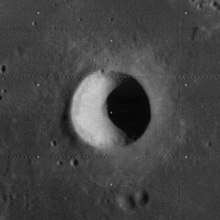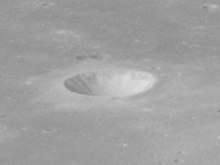Rosse (crater)
Rosse is a bowl-shaped lunar impact crater located in the southern part of Mare Nectaris. It was named after Irish astronomer Lord Rosse.[1] To the southwest is the large, flooded crater Fracastorius.
 Lunar Orbiter 4 image | |
| Coordinates | 17.9°S 35.0°E |
|---|---|
| Diameter | 12 km |
| Depth | 2.4 km |
| Colongitude | 326° at sunrise |
| Eponym | Lord Rosse |

Oblique view from Apollo 11

Oblique view from Apollo 16
The interior of the crater has a higher albedo than the surrounding lunar mare, making it readily visible. While it lacks a ray system of its own, rays from distant Tycho cross it. Low ridges in the mare lie between this crater and Fracastorius to the southwest.
Satellite craters
By convention these features are identified on lunar maps by placing the letter on the side of the crater midpoint that is closest to Rosse.
| Rosse | Latitude | Longitude | Diameter |
|---|---|---|---|
| C | 18.5° S | 34.4° E | 5 km |
gollark: You're 84 kwrong.
gollark: Exciting news: to fund Macron research we are auctioning Macron as a NFT.
gollark: To Macron development.
gollark: A full commitment's what I'm looking for.
gollark: You know what you did, and so do I.
References
- "Rosse (crater)". Gazetteer of Planetary Nomenclature. USGS Astrogeology Research Program.
- Andersson, L. E.; Whitaker, E. A. (1982). NASA Catalogue of Lunar Nomenclature. NASA RP-1097.CS1 maint: ref=harv (link)
- Bussey, B.; Spudis, P. (2004). The Clementine Atlas of the Moon. New York: Cambridge University Press. ISBN 978-0-521-81528-4.CS1 maint: ref=harv (link)
- Cocks, Elijah E.; Cocks, Josiah C. (1995). Who's Who on the Moon: A Biographical Dictionary of Lunar Nomenclature. Tudor Publishers. ISBN 978-0-936389-27-1.CS1 maint: ref=harv (link)
- McDowell, Jonathan (July 15, 2007). "Lunar Nomenclature". Jonathan's Space Report. Retrieved 2007-10-24.CS1 maint: ref=harv (link)
- Menzel, D. H.; Minnaert, M.; Levin, B.; Dollfus, A.; Bell, B. (1971). "Report on Lunar Nomenclature by the Working Group of Commission 17 of the IAU". Space Science Reviews. 12 (2): 136–186. Bibcode:1971SSRv...12..136M. doi:10.1007/BF00171763.CS1 maint: ref=harv (link)
- Moore, Patrick (2001). On the Moon. Sterling Publishing Co. ISBN 978-0-304-35469-6.CS1 maint: ref=harv (link)
- Price, Fred W. (1988). The Moon Observer's Handbook. Cambridge University Press. ISBN 978-0-521-33500-3.CS1 maint: ref=harv (link)
- Rükl, Antonín (1990). Atlas of the Moon. Kalmbach Books. ISBN 978-0-913135-17-4.CS1 maint: ref=harv (link)
- Webb, Rev. T. W. (1962). Celestial Objects for Common Telescopes (6th revised ed.). Dover. ISBN 978-0-486-20917-3.CS1 maint: ref=harv (link)
- Whitaker, Ewen A. (1999). Mapping and Naming the Moon. Cambridge University Press. ISBN 978-0-521-62248-6.CS1 maint: ref=harv (link)
- Wlasuk, Peter T. (2000). Observing the Moon. Springer. ISBN 978-1-85233-193-1.CS1 maint: ref=harv (link)
This article is issued from Wikipedia. The text is licensed under Creative Commons - Attribution - Sharealike. Additional terms may apply for the media files.